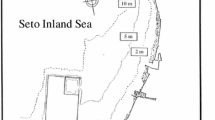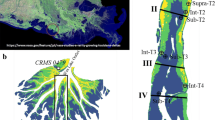Abstract
The change in porewater nitrate (NO2 − + NO3 −) concentrations during exposure of intertidal sediment was studied at a fixed location in the Sado estuary, southwest Portugal, in November 1994. In order to follow nitrate concentration and dynamics from pre-ebb to post flood, during the day, high vertical resolution profiles (0.2 cm) were studied. As a complement, in February 1995, potential nitrification rates in the sediment were measured by laboratory incubations, with high vertical resolution (0.2 cm) up to 3 cm depth. Oxygen penetration was measured with polarographic mini-electrodes. The sediment’s texture as well as the organic matter composition in carbon and nitrogen were studied in deeper (30 cm) cores. In February 1993,210Pb activity depth profiles were measured in a core sampled at the beginning of exposure, in order to evaluate the possibility of nonlocal particle exchange. C:N ratios and210Pb activity profiles show evidence of nonlocal exchange of solid phase particles between the surface and deeper sediment, most likely due to macrofaunal activity. As a consequence, fresh organic matter is brought from the surface to 7–9 cm depth, causing enhancement of nutrient concentrations. Results of this study suggest nitrate dynamics in intertidal sediments of the Sado estuary are strongly influenced by tidal action. Periodic submersion and exposure allow for the diversification of pathways of oxygen supply to the sediment. Tidal stress at the sediment-water interface during the arrival (flooding) and departure (exposure) of the tidal front at the site has an important bearing on the effective depth of the nitrification zone. A denitrification rate of 2.16 μmol N dm−5 h−1 was measured directly from the nitrate inventory in the 1.5–6 cm depth layer. The schematic model of N cycling in these sediments suggests that 20% of the N pool is denitrified during exposure, and that this process is limited by O2 availability for nitrification.
Similar content being viewed by others
Literature Cited
Allen, J. R. L. 1994. A continuity-based sedimentological model for temperate-zone tidal salt marshes.Journal of the Geological Society, London 151:41–49.
Anderson, F. E. 1983. The northern muddy intertidal: Seasonal factors controlling erosion and deposition—A review.Canadian Journal of Fisheries and Aquatic Sciences 40 (Suppl. 1):143–159.
Anderson, F. E. andB. A. Howell. 1984. Dewatering of an unvegetated muddy tidal flat during exposure-Dessication or drainage?Estuaries 6:225–232.
Bacon, M. P., R. A. Belastock, M. Tecotzky, K. K. Turekian, andD. W. Spencer. 1988. Lead-210 and Polonium-210 in ocean water profiles of the continental shelf and slope south of New England.Continental Shelf Research 8:841–853.
Blackburn, T. H. andK. Henriksen. 1983. Nitrogen cycling in different types of sediments from Danish waters.Limnology and Oceanography 28:477–493.
Bradley, P. M. andJ. T. Morris. 1990. Physical characteristics of salt marsh sediments: Ecological implications.Marine Ecology Progress Series 61:245–252.
Darcy, H. 1856. Les Fontaines Publiques de la Ville de Dijon. Dalmont, Paris.
Dolphin, T. J., T. M. Hume andK. E. Parnell. 1995. Oceanographic processes and sediment mixing on a sand flat in an enclosed sea, Manukau Harbor, New Zealand.Marine Geology 128:169–181.
Domenico, P. A. andF. W. Schwartz. 1990. Physical and Chemical Hydrogeology, John Wiley & Sons, New York.
Falcão, M. andC. Vale. 1995. Tidal flushing of ammonium from intertidal sediments of Ria Formosa, Portugal.Netherland’s Journal of Aquatic Ecology 29:239–244.
Fleer, A. P. andM. P. Bacon. 1984. Determination of lead-210 and polonium-210 in seawater and marine particulate matter.Nuclear Instruments and Methods in Physicals Research 223:243–249.
Gardner, L. B. 1975. Runoff from an intertidal marsh during tidal exposure—Recession curves and chemical characteristics.Limnology and Oceanography 20:81–89.
Grundmanis, V. andJ. W. Murray. 1977. Nitrification and denitrification in marine sediments of Puget Sound.Limnology and Oceanography 28:804–813.
Hakanson, L. andM. Jansson. 1983. Principles of Lake Sedimentology. Springer-Verlag, Berlin.
Harvey, J. W. andW. E. Odum. 1990. The influence of tidal marshes on upland groundwater discharge into estuaries.Biogeochemistry 10:217–236.
Hemond, H. A. andJ. L. Fifield. 1982. Subsurface flow in salt marsh peat: A model and field study.Limnology and Oceanography 27:126–136.
Henriksen, K., J. I. Hansen, andT. H. Blackburn. 1981. Rates of nitrification, distribution of nitrifying bacteria, and nitrate fluxes in different types of sediment from Danish coastal waters.Marine Biology 61:299–304.
Henriksen, K. andW. M. Kemp. 1988. Nitrification in estuarine and coastal sediments, p. 207–249.In T. H. Blackbum and J. Sorensen (eds.), Nitrogen Cycling in Coastal and Marine Environments. Scientific Committee on Problems of the Environment, John Wiley & Sons, United Kingdom.
Hirota, J. andJ. P. Szyper. 1975. Separation of total particulate carbon into organic and inorganic components.Limnology and Oceanography 6:896–900.
Huettel, M. and G. Gust. 1992a. Bioroughness in the milimeter scale enhances interfacial solute fluxes in permeable sediments, ASLO-Aquatic Sciences Meeting Abstracts, American Society of Limnology and Oceanography. Lawrence, Kansas. Abstract volume. p. 97.
Huettel, M. andG. Gust. 1992b. Solute release mechanisms from confined sediment cores in stirred benthic chambers and flume flows.Marine Ecology Progress Series 82:187–197.
de Jonge, V. N. andJ. E. E. van Beusekom 1995. Wind and tide-induced resuspension of sediment and microphytobenthos from tidal flats of the Ems estuary.Limnology and Oceanography 40:766–778.
Jorgensen, B. B. 1983. Processes at the sediment-water interface, p. 477–515.In B. Bolin and R. B. Cook, (eds.), The Major Biogeochemical Cycles and Their Interactions. Scientific Committee on Problems of the Environment, John Wiley & Sons, United Kingdom.
Kerner, M., H. Kausch, andG. Mehlich. 1990. The effect of tidal action on the transformations of nitrogen in freshwater tidal flat sediments.Archiv für Hydrobiologie Supplement 75:251–271.
Klump, J. V. andC. S. Martens. 1989. The seasonality of the nutrient regeneration in an organic-rich coastal sediment: Kinetic modelling of changing pore water nutrient and sulfate distributions.Limnology and Oceanography 34:559–577.
van der Loeff, R. 1981. Wave effects on sediment water exchange in a submerged sand bed.Netherlands Journal of Sea Research 15:100–112.
Middelburg, J. J., G. Klaver, J. Nieuwenhuize, A. Wielemaker, W. de Haas, T. Vlug, andJ. F. W. A. van der Nat. 1996. Organic matter mineralization in intertidal sediments along an estuarine gradient.Marine Ecology Progress Series 132:157–168.
Nielsen, L. P. 1993. Denitrification in microbial gradient communities, p. 153–156.In R. Guerrero and C. Pedrós-Alió (eds.), Trends in Microbial Ecology. Spanish Society for Microbiology.
Nixon, S. W. 1981. Remineralization and nutrient cycling in coastal marine environments, p. 111–138.In B. Neilson and L. Cronin (eds.), Estuaries and Nutrients, Humana Press, Clifton, New Jersey.
Oremland, R. S. andD. S. Capone. 1988. Use of “specific” Inhibitors in biogeochemistry and microbial ecology.Advanced Microbial Ecology 10:286–383.
Risgaard-Petersen, N., S. Rysgaard, L. P. Nielsen, andN. P. Revsbech. 1994. Diumal variation of denitrification and nitrification in sediments colonized by benthic microphytes.Limnology and Oceanography 39:573–579.
Rocha, C. 1998. Rhythmic ammonium regeneration and flushing in intertidal sediments of the Sado estuary.Limnology and Oceanography 43:823–831.
Rocha, C., G. Cabeçadas, andM. J. Brogueira. 1995a. On the importance of sediment-water exchange processes of ammonia to primary production in shallow areas of the Sado estuary (Portugal).Netherlands Journal of Aquatic Ecology 29:265–273.
Rocha, C., M. J. Madureira, andM. Caetano. 1995b. Role of microorganisms in mineralization processes in intertidal surface sediments subject to high temperatures: An incubation experiment.Netherlands Journal of Aquatic Ecology 29:257–263.
Turner, I. L. 1995. Modelling the time-varying extent of groundwater seepage on tidal beaches.Earth Surface Processes and Landforms 20:833–843.
Vanderborght, J. P., R. Wollast, andG. Billen. 1977. Kinetic models of diagenesis in disturbed sediments. Part 2. Nitrogen diagenesis.Limnology and Oceanography 22:794–803.
Webb, J. E. andJ. L. Theodor. 1968. Irrigation of submerged marine sands through wave action.Nature 220:682–683.
Webb, J. E. andJ. L. Theodor. 1972. Wave-induced circulation in submerged sands.Journal of the Marine Biology Association of the United Kingdom 52:903–914.
Author information
Authors and Affiliations
Corresponding author
Rights and permissions
About this article
Cite this article
Rocha, C., Cabral, A.P. The influence of tidal action on porewater nitrate concentration and dynamics in intertidal sediments of the Sado estuary. Estuaries 21, 635–645 (1998). https://doi.org/10.2307/1353301
Received:
Accepted:
Issue Date:
DOI: https://doi.org/10.2307/1353301




